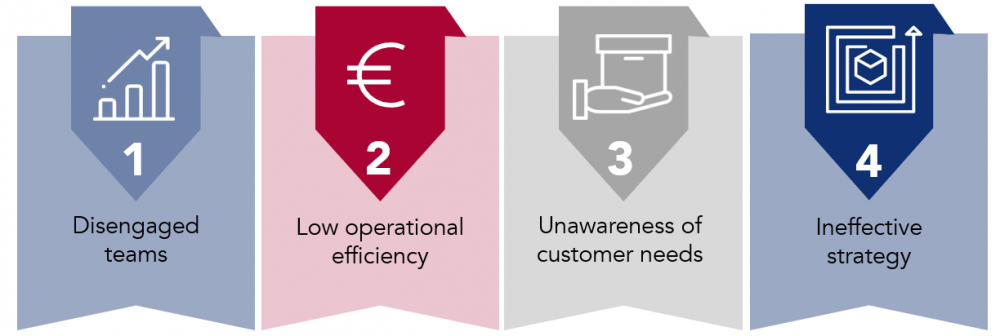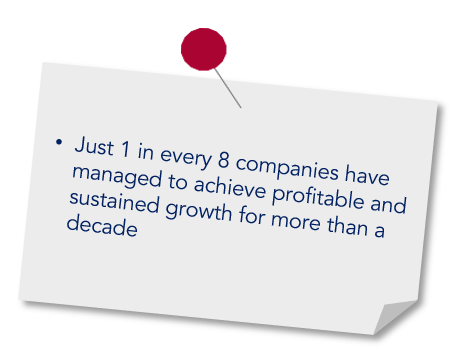Context
The average lifespan of companies is on the decline, and this is expected to be the case into the foreseeable future. Many companies collapse during periods of crisis, but indeed the major cause of such collapses proves to be the inability of an organisation to overcome its own inertia, by being held hostage to the systems and processes originally created. What do companies like Porsche, Amazon and Danaher have in common? Organisational agility and a change culture as a means to remain on top.
Problem

The nature of the problems that inhibit organisations from quickly adapting to change vary depending on the sector within which they operate. However, there are four inhibitors that are common across different organisations, these are Team Engagement, Operational Efficiency, Awareness of Customer Needs and Strategy Effectiveness.
1. An organisation is agile in its transformation if its teams are motivated and if it is able to measure and leverage its performance and resilience. Indicators such as productivity and efficiency are the most common, while absenteeism, motivation and involvement should also not be overlooked.
High absenteeism rates indicate that the processes within an organisation may not ensure the well-being of its employees. It is an important indicator of the mental health of employees and demonstrates the willingness of employees to turn up to work as normal. In Spain, absenteeism in 2018 reached 5.3%. In France, this figure was 5.1%. European figures range from 3% to 6%. As far as performance monitoring is concerned, only 8% of companies consider their indicator monitoring systems as effectively promoting value creation.
2. The second organisational change inhibitor is operating efficiency, a low value of which can block EBITDA, generate a longer cash conversion cycle and leverage CAPEX. These three pillars affect cash flow, which is essential to finance a company’s growth. A low operational efficiency is caused by a number of factors, including low service levels, low productivity of resources and/or equipment, rework due to quality problems or low team motivation amongst teams.

3. Companies reinforce their product portfolio as a way of increasing customer satisfaction and market share. However, strategies of this nature do not always come about as a result of the correct understanding of the actual needs of a customer. By following this strategy, companies incorporate two forms of complexity: the proliferation of products and the resulting increase of resources and specifications required. Procter & Gamble Co., after realising this, reduced the number of references of one of its core products, Head & Shoulders, from 26 to 15, which contributed to a 10% increase in sales. Managing a product portfolio has an impact on production, supply and demand:

4. 50% of strategies fail due to the absence of an effective strategy deployment process. The lack of a structure that ensures the definition of goals for each organisational level makes it difficult to develop a culture whereby indicator analysis and countermeasure planning is the norm. Teams do not work together or towards the same common goal, which weakens the results obtained.

Solutions
The problems presented require a coordinated response that should mobilise the entire organisation towards a shared goal of changing for the better and overcoming its natural inertia. This approach should follow a structured process, working on the following aspects:
1. Inclusive culture
- Bringing middle and top management closer to the shop floor teams, creating greater transparency and empathy when hearing their difficulties and improvement suggestions
- Monitor team performance on a daily basis, in accordance with the organisation’s priorities
2. Operational efficiency
- Improve productivity by reducing costs and the need for CAPEX
- Optimise sourcing, production and invoicing processes, shortening the Cash Conversion Cycle and, consequently, the need for Working Capital
3. Voice of Customer (VOC) in Product Portfolio
- VOC collection and the definition of a systematic process for its realisation
- Develop a product development model that includes:
- Value perceived by the customer
- Cost of complexity in different functional areas
- Management of the cultural impact, internally and externally
4. Strat to Action
- Create a structured process that allows the deployment of the strategy at all levels of the organisation
- Empower operational teams to improve
- Create breakthrough moments in key organisational processes, which represent obstacles to strategy implementation
#culture and organisation
See more on Culture & Organisation
Find out more about improving this business area
